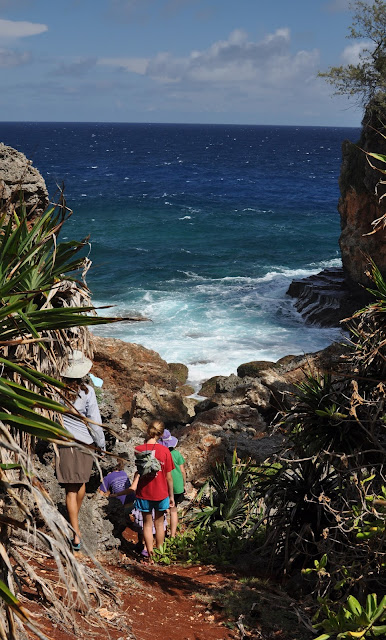 |
| Windy atop the cliffs pointing at a large sea turtle (I circled him in red). We see these guys often from the boat, but this might be the first time from land. |
For
a long time, I’ve realized that it can take at least a few days for me to
assess the personal impact of experiences. I might tell you I liked a book
after I put it down, but if a few days pass and I’m still thinking of it, I’ll then
realize it meant a lot more to me than I knew. Such as it was when the swell
hit Tonga.
We
had the forecast: 10 meter swells generated somewhere far away were set to
pound for days the eastern shores of Vava’u. They came with high winds and
unsettled weather. We debated going out to see the surf. But it would have been
a rough trip and we had a lot to do before leaving Del Viento for our time in
California.
Nonetheless,
moving from a Pangai anchorage back to Neiafu, we motored around Kapa island
and saw the effects of the monster swell. About five miles away, we watched white
plumes of spray rise from behind Luatafito, a small fringing island. Each
appeared to rise in slow motion because of the distance and the scale. At its
peak, each plume would freeze for a second, a massive white backdrop, Luatafito
just a dark outline at its base, before slowly dissipating.
 |
| For perspective, that's Michael atop the cliff across from us. I circled him in red too. |
A
few days later, we spent a few days with the Wondertime crew on Fetoko. Michael
described to us watching the same spectacle from the eastern side of Fetoko,
the swells crashing on the windward side of two-mile-distant Kenutu, sending up
plumes of white like we saw. Given the height of Kenutu, Michael estimated the spray
plumes reached about 200 feet. Even then, days later, there was still swell
action, plumes rising and framing the island.
“Should
we motor over there, check it out?”
We
didn’t. The resort’s restaurant on the west side of the island was a sheltered
playground where the kids were enjoying themselves. There was lunch and then dinner
to make. We were on island time.
A
couple weeks later, just days before we flew out of Tonga, we did go over to Kenutu
with the Wondertime crew. It was a perfect early-summer day. We chatted,
watched the kids play, and drank beer on the sandy western shore. Then we hiked
up and over the small island to the other side, the rugged shoreline where the
Pacific Ocean, unimpeded for thousands of miles, hits hard. The big swells were
gone, but the normal swells and waves surged and crashed at the base of sharp rock
cliffs.
 |
| Windy and the Del Viento and Wondertime girls heeding the Siren calls of the tidepools. |
Atop,
where we stood, 75 feet above sea level was evidence of lots of water damage.
The cliffs where we stood form a bowl that probably exacerbated the swell
action—a convergence zone, a washing machine—and on the cliffs high above the
center, a large scar revealed where earth and vegetation had simply been washed
over. What must it have been like to be there when the big swells were pounding?
Had we gone, I don’t think we’d have been able to get very close, but I loved standing
where I was then and imagining the forces that sent spray from sea water, so
far below me, up to where I was and 125 feet above me.
I
wish we had rallied when the swells were up. Days and weeks have passed and I’m
still thinking about what that would have been like.
--MR
 |
| Sara, Michael, and Windy (from left) finding shade at the top of the Kenutu beach... |
 |
| ...and watching the kids dig on the same beach. |
 |
| Windy and Eleanor. |
 |
| Hard to tell from this picture, but this structure is perched right on the cliff edge. The kids are all sitting on the bench up there, discussing who-knows-what. Fortunately, the structure held. |
 |
| This is part of the area that was apparently washed away, trees and all. |














Great stuff. We have fond memories of Kenutu...
ReplyDelete